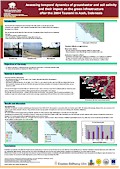| Poster |
 |
|
| Title | Assessing temporal dynamics of groundwater and soil salinity and their impact on the green infrastructure after the 2004 Tsunami in Aceh, Indonesia | | Author | Andreas Distel, Carsten Marohn, Gerd Dercon, Fahmuddin Agus, Laxman Joshi, Meine van Noordwijk, Uwe Meyer and Georg Cadisch | | Year | 2008 | | Publisher | World Agroforestry Centre - ICRAF, SEA Regional Office | | City | Bogor, Indonesia | | Call Number | PO0132-08 |
|
| Abstract: |
| After the 2004 Tsunami the coastal area of West Aceh in Indonesia was flooded up to 5 km land inwards. Land subsidence due to the preceding earthquake and flooding led to saltwater intrusion and mud deposits. In many areas, groundwater salinisation was only temporary, but long enough to cause damage to salt susceptible crops like rambutan and beans. Permanent changes in groundwater quality and level obliged farmers in subsided or deposition areas to change crops or use new varieties.
The aim of the study was to determine the impact of saltwater intrusion, in time, on soil and groundwater quality, as well to assess and to understand consequences for different tree crops. The study focused on ten existing transects perpendicular to the coast of Aceh Barat. Observations on EC, pH, several cations and anions in the groundwater had been analysed in 2006. These measurements were repeated and datasets complemented with secondary data for shallow wells shortly after the tsunami. In addition, soil data and tree damage were assessed. Other relevant secondary data were also consulted.
Salinisation as expressed by electric conductivity generally decreased from 2005 to 2007, with exception to some points which were flooded again in 2007. In general, salinity is not a constraint anymore in most coastal areas. EC declined with increasing distance to the sea or to water bodies connected to the sea. All groundwater samples were appropriate for irrigation and most even passed drinking water thresholds (1000µS/cm). On soil parameters, Na+ concentrations corresponded well with groundwater dynamics. High rainfall in the area helped to leach salts out of the sandy soils. Tsunami mud depositions often had fertilizing effects (e.g. on coconut), but also caused nutrient imbalance to crops such as peanut.
Damage to tree crops ranged from short term effect to complete death of trees. The reasons of this variation include species-specific tolerance to salt (similar to drought tolerance); and distance of trees from the sea (influenced duration and intensity of inundation). |
|
|
Download file(s): Click icon to download/open file.
|
| |
File Size |
Description |

|
645 KB |
Softcopy |
|
|
GRP 6: Developing policies and incentives for multifunctional landscapes with trees that provide environmental services
|
| Viewed in 2207 times. Downloaded in 482 times. |